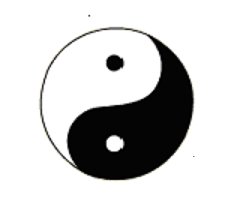
T'ai Chi
comes from
Wu Chi
and is the mother of Yin and Yang.
In motion it separates,
in stillness they fuse.
It is not excessive or deficient;
accordingly when it bends,
it then straightens.
- Wang Tsung-yeuh, "T'ai Ch'i Ch'uan Lun"
Note: This is my first post on Taijiquan and Qigong and is by no means complete. I will follow up with other notions as the time is available and as they present themselves.
A thousand monkeys clamor in my mind much of the time. I have an analytical faculty that almost never spins down. It siezes on negativity, takes it apart, looks at it, and puts it back together again, exactly as it was. My path to depression.
The trick is to calm the mind and there are several approaches to this. There is seated meditation, wherein one focuses on the breath and perhaps contemplates a mantra. Seeking stillness in stillness. This does not work for me. While the mind is in constant motion, it speeds up as physical activity decreases. Action, focused action, helps soothe the mind. Focus on breathing helps slow the mind more. This is where taijiquan and qigong come in.
I have recently begun studying Wudangshan style taijiquan and the 18 Luohan qigong. Both have martial pedigrees, both are concerned with the cultivation of chi (breath, life force) through motion, breathing, inner stillness. My interest in the martial arts is longstanding, though it hs been pursued largely in the academic realm. I studied karate as a teenager, but was ill-equipped to see beyond external fact that it was an efficient way to kick ass. Not that I ever used the talent. Lessons that pointed to the inner nature, the value of karate as meditation, were largely lost or ignored.
In college I was drawn to philosophy, certainly by the same analytical bent that is so useless agianst depression. It was then that I learned of the inner tradition of the martial arts. Beginning with the Bhagavad Gita, transmitted to China by Bodhidharma and to Japan by Lin Chi (Rinzai) was the tradition of movement, and of combat, as a means to enlightenment.
The 18 Luohan are purported to be the original exercises taught to the Shaolin monks by Bodhidharma, patron of Chan (Zen) Buddhism. They may or may not have origninated in the unarmed combat postures of the Indian warrior caste, of which Bodhidharma might have been a member. It is claimed in more than one place the the number of Luohan and the number of poses in Indian vajramukti (again, 18) is no accident. These may also form the basis of Shaolin gongfu, which itself flows into taiji.
Taijiquan and qigong are active versions of Taoist philosophy. Both are forms of moving meditation. In the ancient traditions it was believed that proper performance of the forms was not only a key to victory, but a means to enlightenment. Distinctions between self and other melt away, wholeness is achieved. Harmony with qi brings health and longevity. Balance is the result.
I could use a little balance. But I have no truck with enlightenment, nor with the mystical conception of qi. I do know, however, about the value of activity in settling the mind. The state achieved by the practiced taijiquan player or qigong practitioner must be identical to the state of calmness achieved by the proficient karateka, or the professional tennis player(any athlete, in fact) who slips "into the zone." Yet with idea with taijiquan and quigong is to carry this state with you as you leave.
The early results are positive. When feeling stressed, I have performed the first Luohan, Xianren Gongshou, the Immortal's Greeting. A few minutes of the exercise and equilibrium is restored. Taijiquan is a slower route, but seeing the road ahead I am optimistic. I don't expect mystic union with the universe, but who knows?
Caveat: My depression is not your depression. Even at my worst I am pretty well functional. If you are suffering from severe depression, consult a professional.
Suggested Reading
Funakoshi, Gichin, Karate-do: My Way of Life
Laozi (Lao-tzu), Tao Te Ching
Liao, Waysun, The T'ai Chi Classics
Miller, Barbara Stoler (translator), The Bhagavad Gita: Krishna's Counsel in Time of War
Tomio, Nagaboshi, The Bodhisattva Warriors

No comments:
Post a Comment